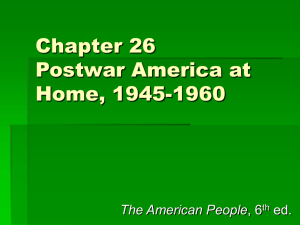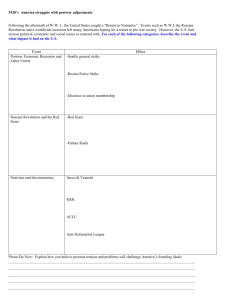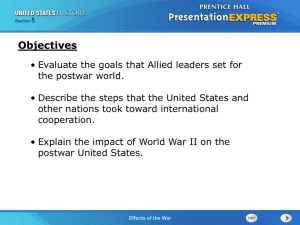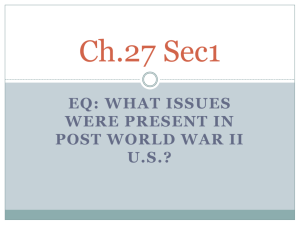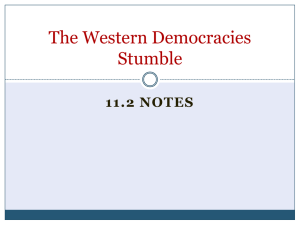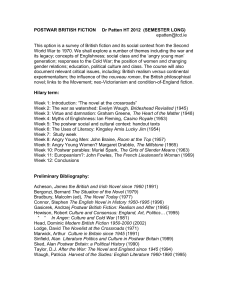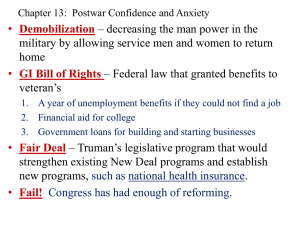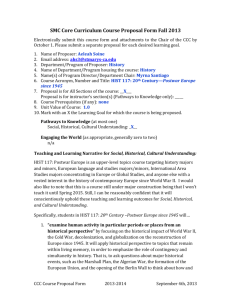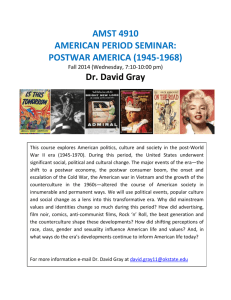Chapter 16 Postwar America 1945
advertisement
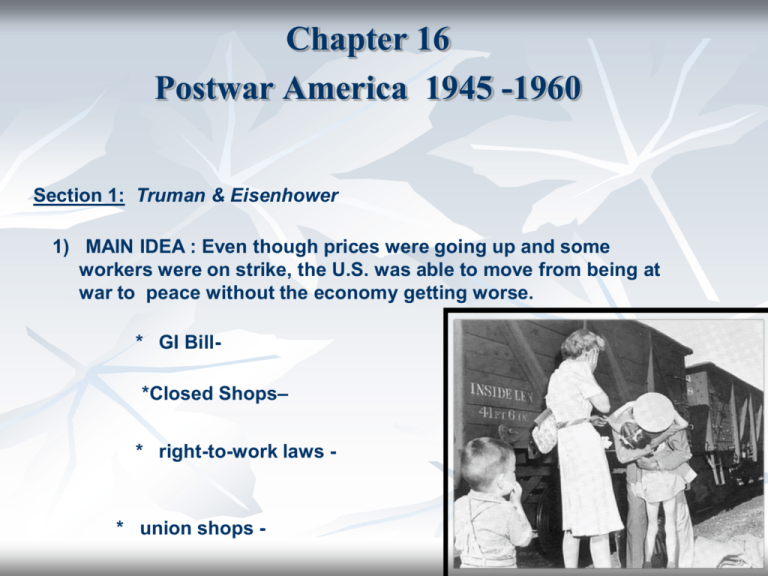
Chapter 16 Postwar America 1945 -1960 Section 1: Truman & Eisenhower 1) MAIN IDEA : Even though prices were going up and some workers were on strike, the U.S. was able to move from being at war to peace without the economy getting worse. * GI Bill*Closed Shops– * right-to-work laws - * union shops - Chapter 16 Postwar America 1945 -1960 Check-Up This act provided money to veterans to help them start businesses, buy homes, and go to college ._________________ Practice of forcing businesses to hire only union members. __________________ Work places where new workers were required to join a union. __________________ Name the law that prohibited this practice. ___________________ Define these terms in your own words: Legislators Inflation Recession Chapter 16 Postwar America 1945 -1960 Section 1: Truman’s Program MAIN IDEA : President Truman wanted all Americans to have a better life a “Fair Deal” ,even though Congress would not pass many of his proposals. •Proposals included•1. •2. •3. •4. •5. •6. •7. Chapter 16 Postwar America 1945 -1960 Election of 1948 - many thought Truman would lose. Within the Democratic party 2 groups emerged – Dixocrat or States Rights Party – nominated Strom Thurmond for president. Progressive Party - nominated Henry A. Wallace for president. Republicans - nominated Thomas Dewey. Truman attacked Republican Congress as “ Do-Nothing Congress, he narrowly won with support of farmers, African-Americans, laborers. Chapter 16 Postwar America 1945 -1960 Check-Up II A group of Southern Democrats did not like Truman’s support of._________________ Thd Dixocrats nominated ________________ to be their candidate for the presidency. __________________ Truman campaigned for the presidency by calling the Congress the ______________________________ List some successes of “The Fair Deal: 1.______________________ 2.______________________ 3.______________________ Chapter 16 Postwar America 1945 -1960 Section 1: The Eisenhower Years 1952 – 1960 “TIME FOR A CHANGE” MAIN IDEA : New Republican winner, Dwight D. Eisenhower cuts federal spending, supports business, begins the Interstate Highway system and extends some programs from the 1940’s. * Middle of the Road – described his political beliefs * Dynamic Conservatism - * Federal Highway Act– Chapter 16 Postwar America 1945 -1960 Section 1: The Eisenhower Years 1952 – 1960 “TIME FOR A CHANGE” • Extended Social Security , unemployment compensation • Raised minimum wage • Gave money to farmers • “Creeping Socialism “– stopped practice of giving money to big institutions like banks and railroads in financial trouble • Ended govt. price/rent controls, believed that business growth was very impt. to success of economy. The first houses ready for residents came in only two styles, a rancher with a front door facing the street and a variant with the main entry facing the side of the house next door. Eventually, Levitt added twostory Cape Cods and colonials to style choices. Unlike Levittown, N.Y., which arose in an improvised frenzy, Levittown, Pa., was planned down to the last shrub and sewer grating. No residential intersection had four corners. No school child would ever have to cross a main street to walk to school. One handy way of navigating Levittown was to do it alphabetically. Every road in Golden Ridge, for instance, began with a "G" — Great Oak Road, Geranium Road, Gable Hill Road. No two styles were ever built side by side. Still, the rows of houses looked so stupefyingly alike that even residents mixed them up. One newcomer, Reuben Sussman, later recalled telephoning for directions to his own house after driving around and around the neighborhood Chapter 16 Postwar America 1945 -1960 Section 2: The Affluent Society MAIN IDEA : The U. S. in the 50’s entered into a time of opportunity with new jobs as white collar workers,families growing and moving from cities to to the suburbs. * Levittown * Baby Boom * White Collar Job*Blue Collar Worker *Multinational Corporation *Franchise - Chapter 16 Postwar America 1945 -1960 Section 2: The Affluent Society MAIN IDEA : A new way of doing business began with the creation of the first computer. Doctors made discoveries which helped fight many illnesses. * ENIAC * Transistor *Cancer/Heart Disease * Tuberculosis *Polio (Jonas Salk )- Negative Stain of the Polio Virus http://www.vaccineinformation.org/polio/photos.asp Effects of Polio http://www.vaccineinformation.org/polio/photos.asp Child w/polio, Rhode Island Epidemic 1960 http://www.vaccineinformation.org/polio/photos.asp Patients with respiratory problems due to polio were placed in iron lungs to help them breathe. http://www.vaccineinformation.org/polio/photos.asp Hospital Respiratory Ward in Los Angeles , 1952 http://www.vaccineinformation.org/polio/photos.asp Homework Due : _____________ Write 1 paragraph from the point of view of a teenager affected with polio and spending time in an iron lung. •Minimum 5 sentences •Correct punctuation/spelling •Worth 10 points •Printed or neat handwriting/printing •Name, period ,date on top of page Chapter 16 Postwar America 1945 -1960 Multinational Corporation Franchise Business Heart Disease Cancer Jonas Salk Tuberculosis Chapter 16 Postwar America 1945 -1960 Section 2: The Affluent Society MAIN IDEA : The popularity of television led to many changes in the movie and radio industries. * By late 1950’s – more than 80% of families had at least 1 TV • Comedy •Action/Adventure •Variety Entertainment •News •Sports *Cinemascope * Radio responds News, weather, sports, talk shows Number of radio stations doubled between 1948 – 1957 – importance of automobile. Chapter 16 Postwar America 1945 -1960 Section 2: The Affluent Society MAIN IDEA :Young people developed their own popular culture based on rock ‘n roll music and literature of the beat movement *Rock ‘n’ Roll •Alan Freed - •King of Rock ‘n’ Roll – * Generation Gap * Beat Movement - •Jack Kerouac * African-American Entertainers Add some pics Chapter 16 Postwar America 1945 -1960 Section 3: The Other Side of American Life MAIN IDEA : Even though much of the U.S. was doing well, there were other groups of U.S. citizens that were very poor and living in poverty. * Poverty Line * Michael Harrington (author) •Poor Included – • Elderly • Single Mothers • Puerto Rican/Mexican Immigrants • Rural Americans (all races) • Inner City Residents Chapter 16 Postwar America 1945 -1960 Section 3: The Other Side of American Life Decline of the Inner City * Urban Renewal * African Americans * Lorraine Hansberry - writer Chapter 16 Postwar America 1945 -1960 Section 3: The Other Side of American Life Hispanics * Bracero Program Chapter 16 Postwar America 1945 -1960 Section 3: The Other Side of American Life Native Americans * Termination Policy Appalachia Chapter 16 Postwar America 1945 -1960 Section 3: The Other Side of American Life MAIN IDEA : Juvenile crime rates rose during the 1950’s , problems in education emerged as baby boomers began school. * Juvenile Delinquency •Experts blamed : • TV • Movies • Comic books • Racism • Busy parents • Divorce rate • Lack of religion • Anxiety over military draft * Parents focused on education as a solution • New schools •Emphasis on math/science – influenced by Sputnik I
